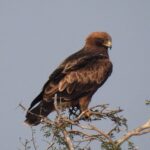Booted Eagles (Hieraaetus pennatus) are known for their impressive flight displays, particularly during their breeding season. These majestic birds take to the skies at specific times of the year, engaging in a variety of aerial maneuvers that captivate birdwatchers and nature enthusiasts alike.
Breeding Season: The Peak of Booted Eagle Flight
The primary time when Booted Eagles take flight is during their breeding season, which typically runs from September to March or April. During this period, both the male and female Booted Eagles participate in spectacular aerial displays, soaring in narrow circles above the forest, diving at treetop level, and then gliding lower above a wider area with almost motionless wings. These flight demonstrations are particularly noticeable when the reproduction process begins, as the adults fly above the forest, calling out loudly to one another.
Migration: Booted Eagles on the Move
 Image source: Booted eagle By Dr. Raju Kasambe
Image source: Booted eagle By Dr. Raju Kasambe
Outside of the breeding season, Booted Eagles tend to be more solitary, but they still often fly together. These birds are primarily migratory, leaving their breeding areas in September and returning in March or April. During their migration, Booted Eagles may follow deflection currents along ridges, escarpments, and larger rivers, where they can hunt for food more effectively.
Hunting Strategies: Booted Eagles in Action
Booted Eagles have a diverse diet, feeding mainly on small and medium-sized birds, small mammals such as mice, reptiles like lizards, and large insects. These birds are capable of hunting in both open and wooded areas, and sometimes the mates will even hunt together, working as a team to secure their prey.
Nesting Behavior: Booted Eagles’ Unique Approach
The Booted Eagle’s nesting behavior is quite unique. They build their nests fairly close to one another, but they do not defend any specific territory. The nest itself is large, with a diameter of 70 cm and a thickness of 30 cm, made with sticks and twigs and lined with green leaves. The female lays two eggs at two or three-day intervals, and the incubation period lasts about 37 to 40 days, during which the male feeds the female.
Chick Development: Rapid Growth and Parental Care
The chicks of Booted Eagles grow rapidly, with the first feathers appearing at 20 days and the complete plumage at 40 days of age. They leave the nest at around 50 to 55 days of age and are fed by both parents near the nest for an additional 40 days or so.
Population Status: Stable Despite Threats
The Booted Eagle’s populations appear to be stable, despite facing threats from habitat loss due to deforestation, human persecution, and a decrease in their favorite prey species. Their unique nesting behavior and adaptability to various hunting environments have likely contributed to their resilience.
In conclusion, Booted Eagles are remarkable birds that take to the skies during their breeding season, engaging in breathtaking flight displays and nesting behaviors. Their migratory patterns and hunting strategies also play a crucial role in their survival and the maintenance of their stable populations. By understanding the when, where, and how of Booted Eagle flight, we can better appreciate and protect these magnificent raptors.

